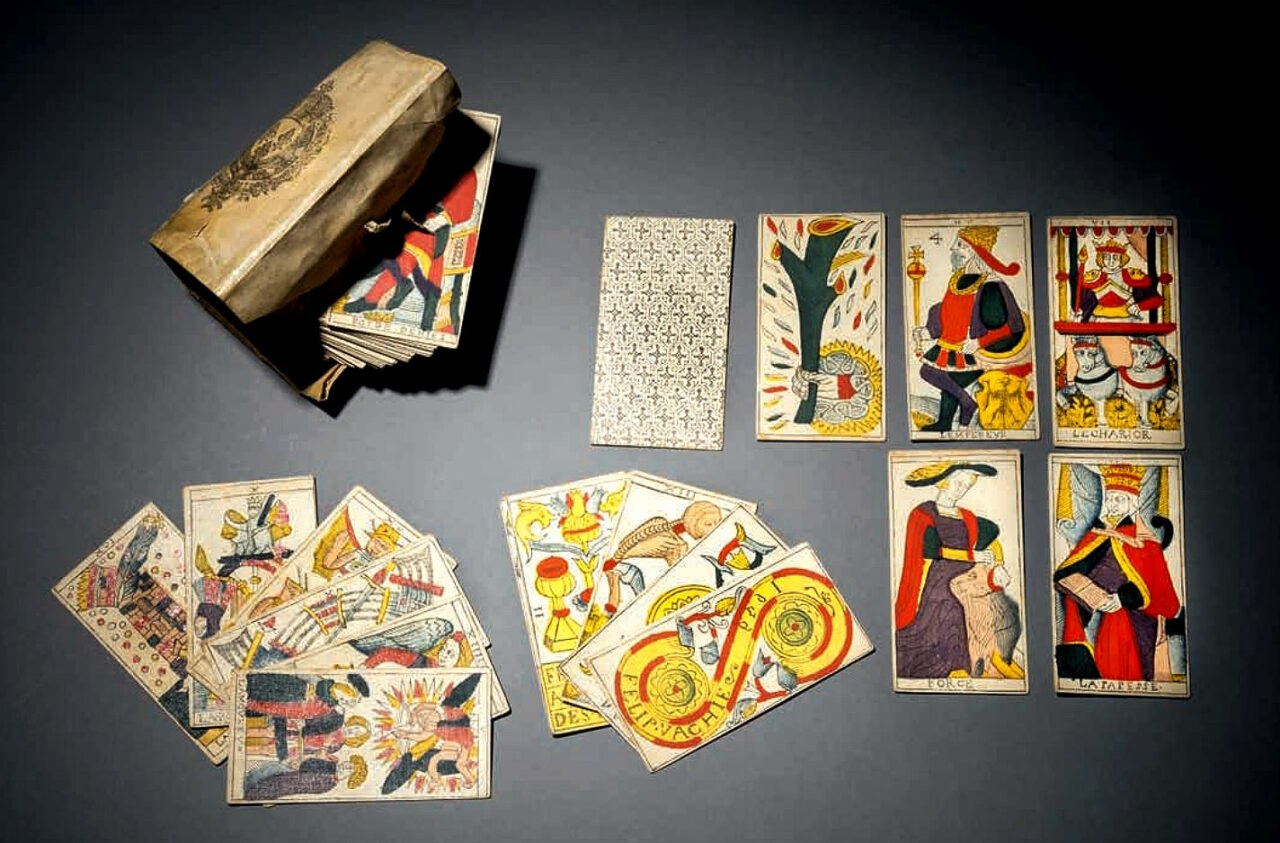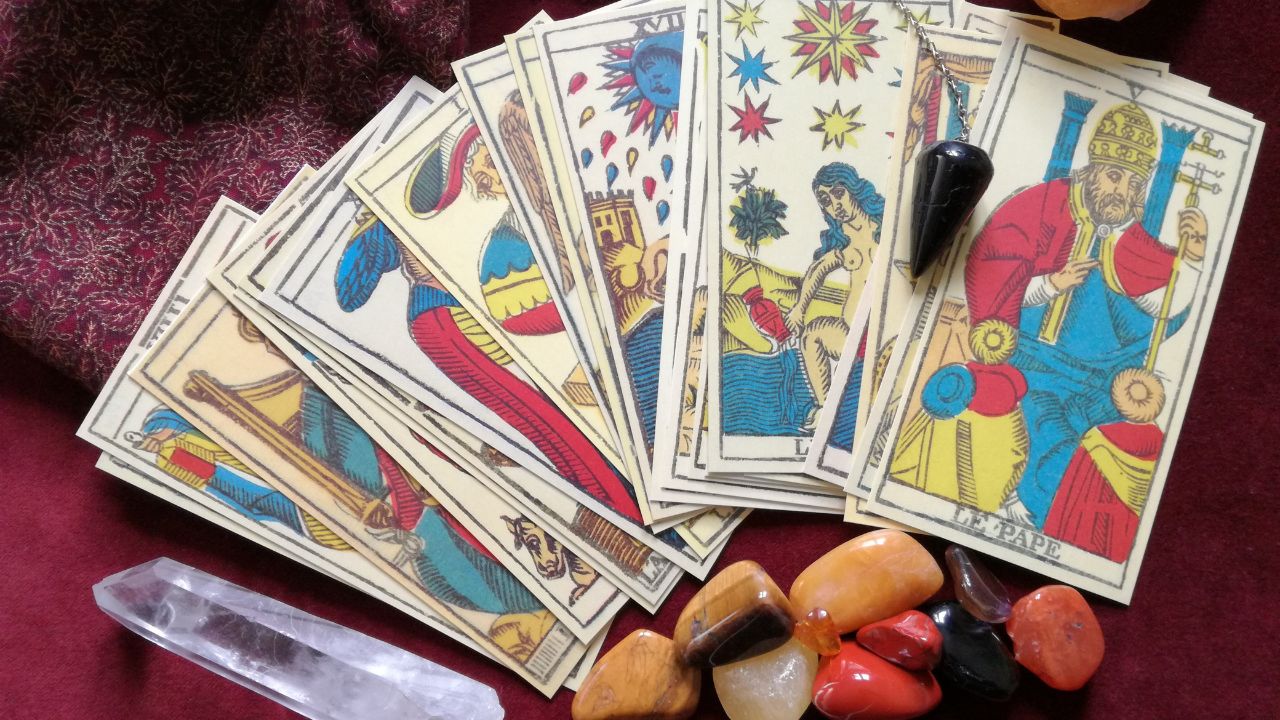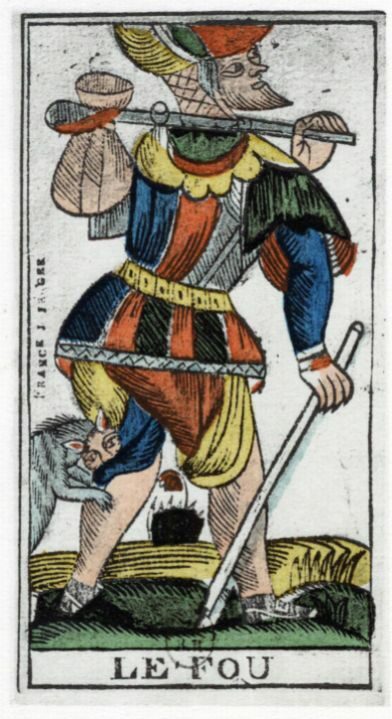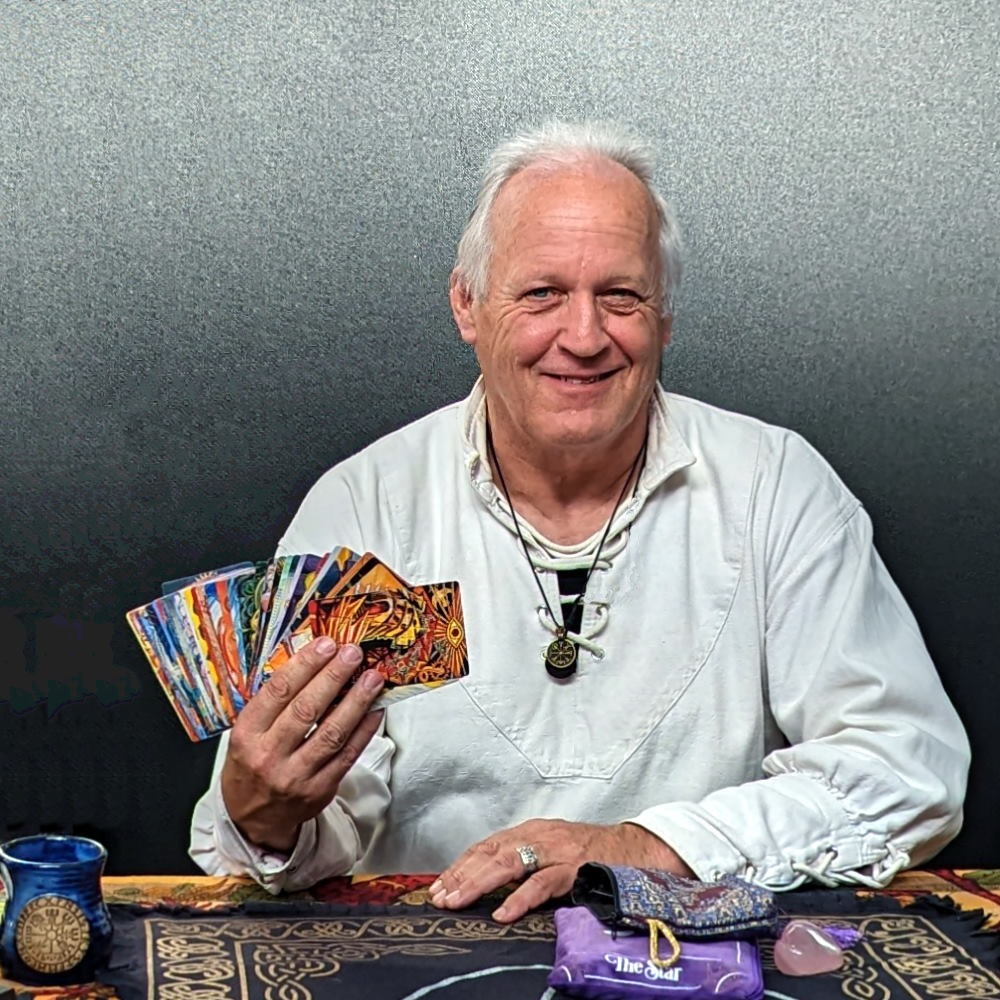The Tarot de Marseille is a type of tarot deck that has its origins in the city of Florence, Italy. It has been made famous in the 18th and 19th century as being produced in, and coming from Marseille, France, hence the name it currently is known as. While the exact history of the Tarot de Marseille is not entirely clear, it is believed to have been developed first during the first half 17th century, although earlier versions of the tarot existed in the region.
Although we know tarot cards were made in Italy since the mid-15th century, the TDM is considered one of the foundational decks of tarot, and many modern tarot decks are based on it. The images on the cards are generally simpler and more geometric than other tarot decks, with a focus on the use of primary colors and bold lines. The Major Arcana cards, which are the 22 cards that represent major life events or archetypes, are particularly distinctive in the Tarot de Marseille, featuring unnumbered cards and unique symbolism.
Over the centuries, the TDM has been used for divination, meditation, and spiritual exploration. It has also been the subject of scholarly study, with researchers examining its origins, symbolism, and cultural significance. Today, the Tarot de Marseille remains a popular tool for those interested in tarot, and it is still used by many tarot readers and spiritual practitioners around the world.
Some of the most well-known variations of the Tarot de Marseille include the Conver deck, the Dodal deck, and the Noblet deck, among others. Each of these decks has its own unique characteristics, such as differences in the style of the artwork, the colours used on the cards, and the specific symbolism that is depicted.

Jacques Vieville
Jacques Vieville is one of the most well-known tarot makers associated with the Tarot de Marseille. He was a French artist who lived in the 17th century and is believed to have created one of the earliest surviving versions of the TDM, which is now known as the Vieville deck.
The Vieville deck is notable for its intricate designs and use of detailed, naturalistic imagery, which sets it apart from other early tarot decks that often featured simpler, more geometric designs. The deck includes all of the traditional cards of the TDM, including the Major Arcana and the four suits of the Minor Arcana (cups, swords, wands, and coins).
While Vieville’s life is not well-documented, his contribution to the development of the Tarot de Marseille has been widely recognized. The Vieville deck is considered a masterwork of tarot art, and its elegant designs and rich symbolism have inspired countless tarot readers and artists over the centuries. Today, the Vieville deck is still admired for its beauty and complexity, and it remains an important part of the history of the Tarot de Marseille.
Jean Noblet
Jean Noblet was a card-maker who created a tarot card deck in the end of the 17th century in Paris. The deck is now known as the “Noblet” tarot and is one of the oldest surviving tarot decks. The only known remaining copy is unusual in size and missing five cards. Despite its incompleteness, it is still considered an important historical artifact that provides insight into the development of the tarot. The deck features intricate woodcut designs with hand-stenciled coloring and captions in French. While we know little about Jean Noblet himself, his tarot deck has become a valuable resource for tarot historians and enthusiasts alike.
Nicolas Conver, Jean Dodal and Claude Burdel
Jean Dodal and Nicolas Conver are two of the most well-known tarot makers associated with the Tarot de Marseille, and they both produced decks that are highly regarded by tarot enthusiasts.
Jean Dodal was a French card maker who lived in Lyon in the 18th century. He is believed to have created a tarot deck that is now known as the Dodal Tarot, which is notable for its intricate, detailed artwork and rich symbolism. The Dodal Tarot includes all of the traditional cards of the TDM, and it has become a popular choice among tarot readers for its beautiful designs and powerful imagery.
Nicolas Conver was another French card maker who lived in Marseille in the 18th century. He is best known for producing a tarot deck that is now known as the Conver Tarot, which is considered one of the most influential versions of the TDM. The Conver Tarot features bold, vibrant colors and stylized designs that are highly recognizable, and it has been used by countless tarot readers and spiritual practitioners over the centuries.
Claude Burdel was a Swiss card maker who lived in Geneva in the 18th century and is known for creating a tarot deck that is now known as the Burdel Tarot. Burdel’s Tarot is one of the most well-known and widely used versions of the TDM, and it has been praised for its beautiful designs and powerful symbolism.
The Burdel Tarot
The Burdel Tarot includes all of the traditional cards of the Tarot de Marseille, including the Major Arcana and the four suits of the Minor Arcana (cups, swords, wands, and coins). The cards feature bold, vibrant colors and intricate, detailed designs that are highly recognizable.
One of the distinctive features of the Burdel Tarot is the inclusion of a unique set of symbols on the cards, which Burdel claimed were based on ancient Egyptian hieroglyphics. These symbols have become an important part of the deck’s symbolism, and they are often used by tarot readers to add depth and nuance to their interpretations of the cards.
The Dodal, Confer and Burdel Tarots are highly regarded by tarot enthusiasts, and they remain popular choices for those interested in the TDM today.
The oldest known Marseille deck

This is a tarot card deck created by Philippe Vachier in Marseilles in 1639. The deck comprises 78 cards made from woodcut with stencil colors and has Latin signs on it. The cards are 122 x 64 mm in size with captions in French. On the back of the cards, there is a network of hexagons with a black pattone cross inscribed on it. The words “FELIP.VACHIE / 1639” are on the 2D card, and “FELIP.VACHIE / A.LENSEGNE / DES.DVSROIS” (probably “In the sign of the two kings”) are on the 2 of Cups card.
Before 1800, there were almost no “Marseille” tarot cards. The only known deck from that time is the one made by Jean Noblet in Paris in the middle of the 17th century, which is unusually small in size and missing five cards. The tarot deck made by “Felip Vachie” (Philippe Vachier) is probably the oldest known “Marseille” tarot deck. Vachier was a cardmaker who worked in Marseille from 1632 to around 1670. The deck is complete and in good condition and bears the date 1639 (engraved upside down).
This deck is an exceptional and rare historical monument that informs us about the seniority and permanence of the model. It has a great range of colors and is in excellent general condition, with only some tiny water stains that are barely perceptible at the bottom of certain cards. This is supposedly the only one copy of this deck in the world, discovered by Frenchman Thierry Depaulis,. It went to auction in March 2023 with a guide price of 3000-4000 Euro.

Tarot de Marseille Makers
Here is a list of some of the known tarot makers associated with the Tarot de Marseille:
- Filip Vachie – Philippe Vachier (17th century – †1676)
- Jacques Vieville (fl. 1643-1660)
- Francois Chosson (1672-1736)
- Jean Dodal (17th century)
- Nicolas Conver (d. 1760)
- Jean-Pierre Payen (18th century)
- Pierre Made nié (17th century)
- François Tourcaty (17th century)
- Jean Noblet (17th century)
- Jean-Baptiste Pitois (18th century)
- Jacques Bellin (fl. 1740-1780)
- Claude Burdel (1727-1799)
- Jean Baptiste Alliette (1738-1791)
- Paul Marteau (1899-1966)

Tarot de Marseille Preservation
There are many individuals and businesses involved in the restoration, reproduction, and preservation of Tarot de Marseille decks. These individuals and groups are dedicated to reviving the traditional art of Tarot-making and preserving the historic significance of these decks.
Some specialize in restoring old, damaged decks, using traditional techniques to repair and recreate missing or damaged cards. Others focus on reproducing historic Tarot de Marseille decks using traditional printing methods, such as letterpress or silk-screening, to create high-quality, authentic reproductions.
In addition, there are many artists who create their own versions of Tarot de Marseille decks, drawing inspiration from historic decks while adding their own unique interpretations and artistic styles. These artists often use traditional techniques such as hand-painting or letterpress printing to create one-of-a-kind Tarot decks.
There are some that prioritize the preservation of historic Tarot de Marseille decks, working to maintain and protect these valuable artifacts for future generations. This may include creating digital archives of historic decks, educating the public on the history and significance of Tarot de Marseille, or working with museums and cultural institutions to ensure that these decks are properly stored and displayed.
Modern Businesses creating Marseille Decks
Overall, the individuals and businesses involved in the restoration, reproduction, and preservation of Marseille Tarot decks play an important role in keeping this rich tradition alive and accessible to Tarot enthusiasts and historians alike. Here is a list of some businesses and individuals who are involved in the restoration, reproduction, or preservation of TDM decks:
- Tarot Sheet Revival: https://www.tarotsheetrevival.com/ (restoration and reproduction of vintage tarot sheets)
- Yves Reynaud: http://www.tarot-history.com/ (restoration and reproduction of antique and vintage tarot decks)
- Tarot-de-Marseilles-Heritage: https://tarot-de-marseille-heritage.com/ (preservation and digitization of antique and vintage tarot decks)
- Philippe Camoin: https://www.camoin.com/ (reproduction of historical TDM decks)
- Jean-Claude Flornoy: https://en.wikipedia.org/wiki/Jean-Claude_Flornoy (restoration and reproduction of antique and vintage tarot decks)
- Museo dei Tarocchi: http://www.museodeitarocchi.it/ (preservation and display of antique and vintage tarot decks)
- Artisan Tarot: https://artisantarot.com (reproduction of historical TDM decks)
- Alejandro Jodorowsky/Philippe Camoin: https://en.camoin.com/tarot/Tarot-Marseilles-Camoin-Jodorowsky.html (reproduction of historical TDM decks)
- Jan Tetteroo: Get your TDM cards read by the writer of this article: https://jantetteroo.com/bookings/


